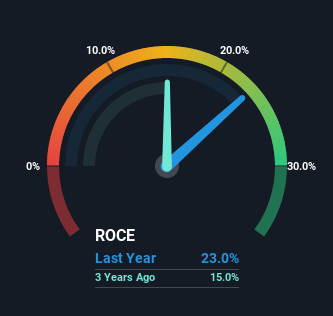- United Kingdom
- /
- Food and Staples Retail
- /
- AIM:VINO
We Think Virgin Wines UK (LON:VINO) Might Have The DNA Of A Multi-Bagger

What are the early trends we should look for to identify a stock that could multiply in value over the long term? Typically, we'll want to notice a trend of growing return on capital employed (ROCE) and alongside that, an expanding base of capital employed. Ultimately, this demonstrates that it's a business that is reinvesting profits at increasing rates of return. Speaking of which, we noticed some great changes in Virgin Wines UK's (LON:VINO) returns on capital, so let's have a look.
Understanding Return On Capital Employed (ROCE)
For those that aren't sure what ROCE is, it measures the amount of pre-tax profits a company can generate from the capital employed in its business. To calculate this metric for Virgin Wines UK, this is the formula:
Return on Capital Employed = Earnings Before Interest and Tax (EBIT) ÷ (Total Assets - Current Liabilities)
0.23 = UK£5.3m ÷ (UK£45m - UK£22m) (Based on the trailing twelve months to December 2021).
Thus, Virgin Wines UK has an ROCE of 23%. That's a fantastic return and not only that, it outpaces the average of 8.6% earned by companies in a similar industry.
See our latest analysis for Virgin Wines UK

In the above chart we have measured Virgin Wines UK's prior ROCE against its prior performance, but the future is arguably more important. If you'd like, you can check out the forecasts from the analysts covering Virgin Wines UK here for free.
The Trend Of ROCE
We like the trends that we're seeing from Virgin Wines UK. Over the last five years, returns on capital employed have risen substantially to 23%. The amount of capital employed has increased too, by 58%. This can indicate that there's plenty of opportunities to invest capital internally and at ever higher rates, a combination that's common among multi-baggers.
On a side note, we noticed that the improvement in ROCE appears to be partly fueled by an increase in current liabilities. Effectively this means that suppliers or short-term creditors are now funding 49% of the business, which is more than it was five years ago. And with current liabilities at those levels, that's pretty high.
The Key Takeaway
A company that is growing its returns on capital and can consistently reinvest in itself is a highly sought after trait, and that's what Virgin Wines UK has. Astute investors may have an opportunity here because the stock has declined 55% in the last year. So researching this company further and determining whether or not these trends will continue seems justified.
If you'd like to know about the risks facing Virgin Wines UK, we've discovered 2 warning signs that you should be aware of.
If you'd like to see other companies earning high returns, check out our free list of companies earning high returns with solid balance sheets here.
New: Manage All Your Stock Portfolios in One Place
We've created the ultimate portfolio companion for stock investors, and it's free.
• Connect an unlimited number of Portfolios and see your total in one currency
• Be alerted to new Warning Signs or Risks via email or mobile
• Track the Fair Value of your stocks
Have feedback on this article? Concerned about the content? Get in touch with us directly. Alternatively, email editorial-team (at) simplywallst.com.
This article by Simply Wall St is general in nature. We provide commentary based on historical data and analyst forecasts only using an unbiased methodology and our articles are not intended to be financial advice. It does not constitute a recommendation to buy or sell any stock, and does not take account of your objectives, or your financial situation. We aim to bring you long-term focused analysis driven by fundamental data. Note that our analysis may not factor in the latest price-sensitive company announcements or qualitative material. Simply Wall St has no position in any stocks mentioned.
About AIM:VINO
Virgin Wines UK
Operates as a direct-to-consumer online wine retailer in the United Kingdom.
Flawless balance sheet and good value.
Similar Companies
Market Insights
Community Narratives




